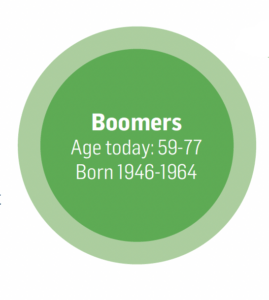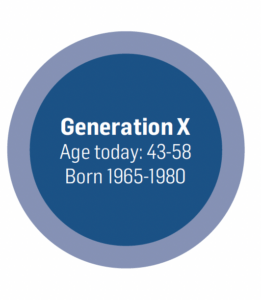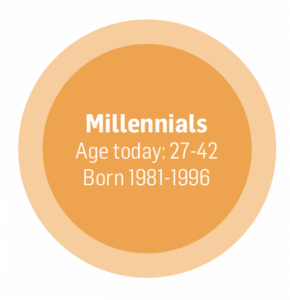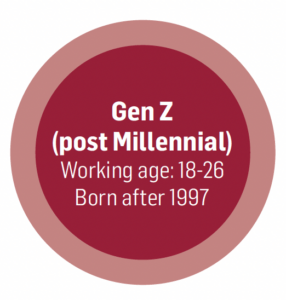
Researchers and marketers around the globe have conducted countless studies on the key generational groups—along with their buying habits and purchasing power—across a variety of consumer segments. While it might be tempting to rely heavily on broad conclusions, there are common themes emerging from the vast amount of research conducted in the field of generational marketing.
For instance, Millennials are clearly the target audience for most marketers today. Studies have consistently shown how this group has demonstrated its growing purchasing power and influence. According to Accenture, millennials spend about $600 billion in the United States each year and their average yearly expenditures in the neighborhood of $47,000.
Millennials are not just an influential group among the generations; they are also growing in numbers. AHF Products, the largest hardwood flooring producer and a major player in the hard surface arena with 14 brands, estimates there are anywhere from 80 million to 95 million millennials today—that’s roughly 30% of the U.S. population. “That’s a lot of people,” said Kevin Whaley, vice president of sales, product and marketing for the company’s tmbr brand, which is specifically geared toward millennials. “More importantly, they are entering the home buying years, and they have outpaced baby boomers. This will only continue to grow.”
However, while Millennials represent the largest group of consumers of any of the current generations, it’s still the Boomers that have the largest buying power, according to Accenture. Consumers over the age of 50 now account for more than half of all U.S. spending, the firm reported.
Then there’s Gen Z, whose spending power is also on the rise. According to a 2022 Bloomberg report, the young students and professionals that make up this influential cohort command somewhere between $320 billion and $360 billion in disposable income. Furthermore, marketers are beginning to see a considerable shift from the purchasing power of millennials to that of Gen Z.
Measuring apples to apples, however, the purchasing power of Gen Z—although on the rise—is nearly 85% less than Baby Boomers possessed when they were in their 20s. One reason: Gen-Zers have more student debt today. And what about Generation X—the cohort representing those born from 1965 to 1980? According to the World Economic Forum, this segment spent the most money last year, with an average expenditure of $83,357.
But perhaps the most enlightening statistics come from Epsilon, a firm that specializes in cross-generational marketing research. Following are key findings from its most recent cross-generational study, which looks at four primary demographic groups:
 Annual spend on home improvement: $1.841B
Annual spend on home improvement: $1.841B
Total annual spend: $548.1B
Factors that influence their general purchasing decisions: Boomers prefer a pleasant shopping experience that is convenient and straight forward; they aren’t ones to browse and seek out new brands or items. They visit stores where they know the items they’re looking for are available. Boomers also tend to stick to what they know is tried and true.
How they prefer to shop: Older generations prefer in-store shopping to experience products and for easy returns.
 Annual spend on home improvement: $1.853B
Annual spend on home improvement: $1.853B
Total annual spend: $357B
Factors that influence their general purchasing decisions: Before making a purchasing decision, Gen Xers dig into every available resource they can find. Because Gen X straddles the line between digital and traditional media, they look both online and offline to inform their purchasing decisions.
How they prefer to shop: Going to stores is preferable for almost every generation, including Gen X—the only exception is millennials, who shop in-store and online equally.
 Annual spend on home improvement: $1.849B
Annual spend on home improvement: $1.849B
Total annual spend: $322.5B
Factors that influence their general purchasing decisions: Millennials prefer brands that offer a unique experience, value for their money and great customer service. They also tend to be more environmentally conscious in their purchasing decisions. Millennials cite their families (75%) and friends (72%) as the biggest influences on their own shopping habits and purchase decisions.
How they prefer to shop: About 75% of Gen Z and Millennials use smartphones to shop online—more than any other generation. Millennials prefer shopping online for the shipping convenience, which also appeals to boomers and silents.
 Annual spend on home improvement: $1.996B
Annual spend on home improvement: $1.996B
Factors that influence their general purchasing decisions: Gen Zers tend to go for smaller groups and are less impressed by influencers, according to the Pew Research Center.
How they prefer to shop: Gen Z prefers in-store shopping for purchase speed and the social aspect of shopping with friends. Gen Z is 2x more likely to use an online-only store or brand website than any other generation.
